Why We Won’t Be Leaving Afghanistan Any Time Soon
Basically, it's inconsistent with the strategy.
Recently, Doug Mataconis suggested that all U. S. troops could be withdrawn in the foreseeable future. I don’t think that’s likely and in this brief post I’d like to sketch why. In a nutshell, it’s inconsistent with the strategy.
The objectives of the 2001 invasion of Afghanistan were to get Al Qaeda out of the country, keep them there, and remove the regime of their Taliban patrons. With the exception of preventing Al Qaeda’s return to Afghanistan those objectives were accomplished in short order. The remaining objective has proven elusive. Al Qaeda appears to have withdrawn to the area of Pakistan that the Islamabad government is unwilling or unable to control. We are reluctant to invade Pakistan to remove them for multiple reasons including the likelihood of inviting Pakistani response and the possibility of destabilizing the Pakistani government.
The new tactical approach that appears to be emerging is one of degrading Al Qaeda capabilities by the use of drone attacks within nominally Pakistani territory. The drone “kill list” of targets for these attacks does not appear to be decreasing in length. As targets are killed, new names are added to the list. That implies operations that will continue for the foreseeable future.
The Tier II unmanned aerial vehicles (UAVs) used for drone attacks within Pakistan have an operating radius of approximately 500 nautical miles. Wherever they may be controlled from they are based, maintained, and launched from Afghanistan. Ongoing drone attacks require ongoing U. S. military presence in Afghanistan.
There are longer-ranged drones. The Tier II+ UAVs may have an operating radius of as much as 5,000 nautical miles. They are, presumably, used for reconnaissance and cost about ten times as much as the Tier II drones (pictured above). There are also issues of longer procurement time. They aren’t really cost effective for the kind of long term, ongoing drone warfare we’re presently engaged in.
The significant political costs likely to be incurred in the event of an attack mounted by Al Qaeda in Pakistan if it weren’t perceived that everything possible was being done about the situation, short of invasion of Pakistan in which significant numbers of Americans would be likely to be killed. For now the drone campaign satisfies those requirements and I expect it to continue for a good, long time. Consequently, I expect a U. S. military presence in Afghanistan for the foreseeable future.
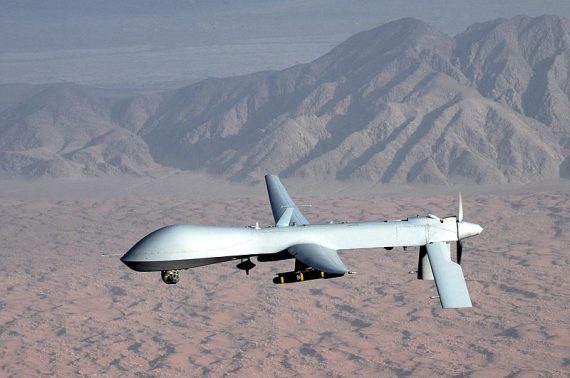

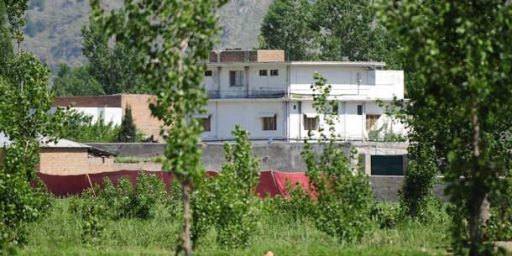

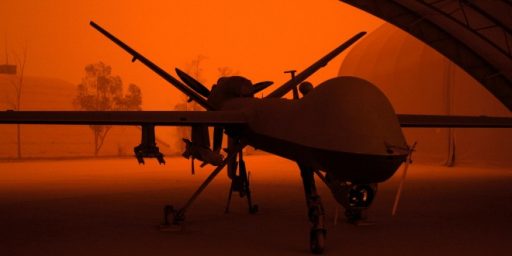
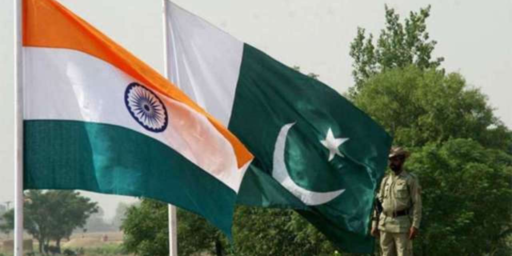
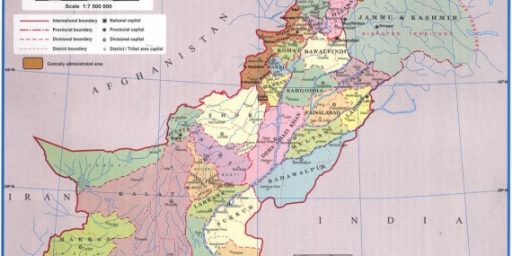
Obviously the drone war is in some part “security theater.” That in the sense that you have to blow up a few houses in order to say later, “we did everything!”
I’m skeptical, Dave. If we get massive troop reductions (which seems almost inevitable at this point), the idea of holding on to a secure location from which to launch drone strikes in Afghanistan seems more and more unlikely. Assuming that the Taliban don’t just over-run the country again, Karzai is going to be in full appeasement mode with them and Pakistan, and that means he’ll be much less amenable for this type of long-term basing.
Like I said in one of the more recent posts on this, look at Iraq. There were plans to keep 50,000 troops there at first for assistance. But once US withdrawal got under way, the political support in the US and Iraq for keeping them there steadily eroded, and now there are none. The same thing will happen in Afghanistan, particularly since it’s even harder to maintain a presence there than in Iraq.
@Brett:
As I read what you’re saying, Brett, the evolving strategy is doomed to failure. That might well be the case. On the other hand, the Karzai government is much more dependent on U. S. patronage than the Iraqi government ever was. I wouldn’t be at all surprised if some sort of deal were cut even though such a deal was impossible in Iraq.
Dave, I think your conclusion is right even if your analysis isn’t. It’s possible to jettison a failed strategy, after all, and events on the ground may force the administration’s hand. But the logistics of withdrawal–just getting all our valuable materiel out–means that we’ll still be there in 2014. We could decide to pull the plug today and it would take that long to extract ourselves just given the infrastructure we’re dealing with for extraction.
This post reminds me of the adage that amateurs talk about tactics and professionals talk about logistics. Can we really pursue a strategy of striking at (or even keeping a watch on) Al-Queda and the Taliban without bases in Afghanistan? Even those who are anti-drone war think its at least a good idea to keep a watch on AQ/T. Remember what happened the last time we didn’t keep a close watch on those guys?
Many people think its a wonderful idea to get out of the Afghan “quagmire”, and I sympathize with that. But it may not be logistically possible, if it means that we let AQ/T go unobserved and unchecked.
@stonetools:
Which Al-Queda, and which Taliban? What fraction give a hoot about actions on US soil?
I think some people have a fantasy of bombing a terrorist planning meeting like some people have a fantasy about a shootout with a crazed gunman. The fantasy doesn’t make itself more likely by repetition. It just leads the fanticist from reality.
(dudes smoking hash in remote Pakistan and talking about bombing NY are only rarely a credible threat)
@john personna:
This post would have made sense on September, 10, 2001. Now, not so much.
We actually know now that al-Queda can launch a devastating assault on an target on US soil from headquarters in Afghanistan. Its been done.
We actually know Al-Queda does give a hoot about actions on US soil. Three thousand dead Americans says so, Internet snark notwithstanding.
Now things have changed since then. But al-Queda hasn’t laid down its arms and and hasn’t forsworn its war on the West. I for one have no doubt that they would do another 9/11 , if given the chance, means, and the breathing space. You may disagree, but the Administration and most people think you are wrong.
So we think we’re going to continue to in effect occupy a remote, landlocked foreign country for perhaps decades in order to maintain a reconnaissance post and high tech sniper blind? Is that what we’re arguing? Sense of proportion?
@stonetools:
There is not a single al-Queda, especially now. Even in its foundation it was a database of likely allies and fellow travelers. Now:
Hence my question, “which al-Qaeda?” Not all of them are focused on attacking US soil. Many of them are focused on the very forward bases you see as defense against them.
Dave,
I think it’s important to point out that military drones are used to support military forces. The drones doing other things, like the “targeted killing” campaign in Pakistan and elsewhere, are operated by other government agencies. So, it is certainly possible to withdraw all troops and still conduct drone operations over Pakistan or anywhere else..
@James Joyner:
I think that’s a doubtful assertion. We’re talking at least a year and our footprint is relatively light. We’d get the vehicles and some other stuff out – most of the rest would just be turned over the to Afghans.
@Andy:
My understanding is that the drones used in the “targeted killing” campaigns are stored, maintained, launched, and, importantly, protected by military personnel. All of this stuff happens on bases built and guarded by military personnel. They’re operated by CIA. If you have information to the contrary, that’s news to me.
If you’re saying that even when all uniformed military personnel have left Afghanistan, the bases will continue to be guarded and operated by CIA personnel or contractors who will also operate the drones, it sounds like a distinction without a difference to me. That doesn’t sound like a handful of drone operators to me. It might provide a figleaf for politicians but we’ll still be operating out of Afghanistan with a substantial presence. If you count a tail as a leg, how many legs does a horse have? Four. Whatever you call it a tail is not a leg.
@Andy: See:
Afghanistan Pullout A Logistical ‘Nightmare’
Report: Logistics for Afghan Withdrawal Flawed
I do agree that we’ll wind up abandoning a lot of material rather than go through the hassle of reimportation.
@Dave Schuler:
Yes, the drones currently operate from bases in Afghanistan. They used to operate from a base in Pakistan. So when you say that ” Ongoing drone attacks require ongoing U. S. military presence in Afghanistan” that simply isn’t true and hasn’t been true for most of the program’s history. The operation could move back to Pakistan. It could remain in Afghanistan and operate from an Afghan-controlled military base. I could operate in Afghanistan with US security, either contract or military. There are a lot of options and the details will be determined by the politics more than anything else. Point being is that it’s certainly possible to continue to the drone program absent US military forces and so the argument that the US can’t fully withdrawal military forces because of the drone program is flawed.
It doesn’t require a large footprint. Wikipedia (grain of salt alert) suggests the in-country CIA component is 150 people. All you really need is a launch and recovery element, plus some maintenance and munitions personnel. I guess it all depends on what one considers a “substantial” presence.
@James Joyner:
No doubt the logistics will be difficult and complicated. However, they won’t drive the bus. The timing of our withdrawal will depend primarily on political factors and not the drone program, or the opinions of logisticians.
@Andy:
And they’re surrounded by substantial military bases. Baghram, for example.
They’re in Afghanistan because we’ve lost access to basing in Pakistan. Do you think we’re going to re-acquire that access in the near future?
@Dave Schuler:
The military just happens to use those bases too – the CIA is there because there are few airfields in Afghanistan.
The program could go back to Pakistan, but it’s anyone’s guess at this point. A lot can happen in the next year. But it seems pretty clear to me after the press conference with Karzai and the President that the drone program won’t keep US troops in Afghanistan. The future looks like Iraq – Afghanistan will not give us immunity in a SOFA and then we will leave. The CIA doesn’t worry so much about SOFA’s….
Oh “which al-Qaeda.” I was flipping channels last night and caught a couple minutes of Al Jazeera. They were talking to a rebel in Syria. They mentioned that many foreign fighters had come from across the region, including Egypt and Libya. So the fighter said something like “why does everyone ask if we are al-Qaeda? We are defending our rights. If al-Qaeda defends our rights, so be it.”
Obviously there might be some worries there about alliances not completely friendly to the US, but we should also note that the focus was not at all “we are getting together to attack NY.”
What if the Arab Spring and al-Qaeda brands blend?
I’d think that would be in our long term interest.
There’s no need to make this assumption based on ‘drones launched into Pakistan’ . Of course ISAF will maintain a presence in Afghanistan. A complete removal of all troops would be a detriment to their overall mission. They’ve only stated that they will end their ‘combat’ role in Afghanistan. They didn’t say they wouldn’t stay on as mentors or as support.
Let’s take a trip in the Wabac Machine:
http://www.nytimes.com/2013/01/14/opinion/100-75-50-years-ago.html?partner=rss&emc=rss
From 1956 through 1962 there were 78 U.S. military fatal casualties of the Vietnam War.
Thirteen years later by 1975 the U.S. Millitary body count was over 58,000.
Read this and weep…